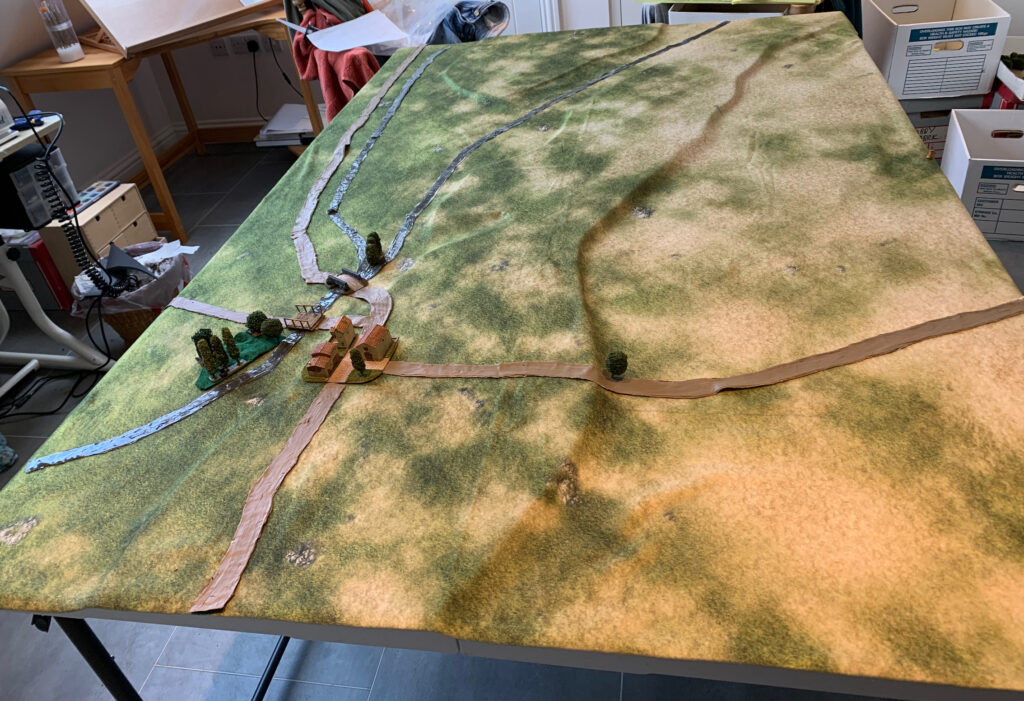Apart from reading, much of my recent hobby time has been devoted to the long-neglected aspect of terrain. I focused on one-third of the field of Waterloo, representing the line of advance of the Prussian IV Corps on Plancenoit. Pretty much all aspects of my terrain needed work, and this is still unfinished. Meanwhile my friend Rob offered me a game. This was not just a chance for me to road-test my new wargames rules, but also an opportunity to try out some terrain ideas.
I picked the Peninsula battle of Albuera. This is on the small side for my rules – suitable for an evening game, but not for the day game we planned. I decided to scale it down, with each base being 600 men or 200 cavalry, and the units being brigades or regiments for the most part. The game-design aspects of this are another story. For now I’m going to look at the table. Albuera was fought in Spain, near the border with Portugal, on terrain that was remarkably empty. It has just one significant habitation, very gentry rolling hills and two streams that merge. This was quite easy to put together quickly – and a good test run for some of my new ideas.
The first problem was how to shape the table. I wanted something between the two extremes of beautifully sculpted boards as seen in exhibition games, and the rapidly assembled table from standard bits that you use for a club game. I decided to go for contoured rather than sculpted hills, at least for the gently rolling terrain that most of the battles I’m interested in were fought on. This is much simpler to assemble, and its flatness makes it much easier to put things like models of buildings on. The big problem is that I want to represent the sweeping shape of valleys and ridges, and not just plonking a few hills on hill pieces on the table, or just leaving the whole thing flat – which are the normal wargames solutions. The technique I have been working on is to place a mat over cut polystyrene. The mat softens the sharp edges of the contours, as well being the fasted way to get a respectable looking surface.
This time I retired by well-worn green felt mat, replacing it with a modern printed fleece mat produced by Geek Villain. I picked their “Sicily” mat, which has the muted colours I am looking for and enough pattern to break things up, without dictating the shape of the terrain. You can see it in the picture. One side is mainly beige, which fades into mainly green. This suits Albuera well, as one side of the table is lightly wooded, and the other dry, featureless farmland. The green is a little strong for my liking, but I think it is as good as it gets when buying off the shelf.
The next innovation was to abandon the lightweight expanded polystyrene (EPS) for the denser extruded polystyrene (XPS). EPS is cheap, and a common packing material (lots of it comes free when you buy stuff), but quite hard to work with. XPS is mainly sold as insulation, and cuts easily with a knife – so long as it is sharp. It is much nicer to work with. It is pricier though. I have been buying off Amazon. My first attempt was a pack of six sheets (10mm thick) of 60cm by 100cm in bright yellow. This cost £40. As I decided I needed more, I found a pack of 5 sheets of 60cm by 120cm (fewer sheets but same area overall) for just £26. This stuff is designed for hiding under floorboards, not for craft use, so the sizes are not precision, and the surface is not always smooth – but as I’m putting a mat over it, that doesn’t really matter.
One thing I had learnt from experiments though, is that it is very useful to be able to stick pins into the board. That means you need a bottom layer covering the whole table – the main reason I needed two packs. That bottom layer can be re-used for different projects, though. Another thing I have learnt the hard way is that to represent gentle terrain you need to keep the number of layers a minimum – preferably just one on top of the base – and represent only the critical features. That means you can’t just work it out from a contour map; it is more art than science. For Albuera the critical terrain was a low ridge passing the length of the table. I had enough bits of board to put in another feature on the top left of the photo. Strictly there should be another low feature running along the right of the table – but this has no game significance, and I decided to save material. I stuck the top layer to the bottom with masking tape and put the mat on top. The fleece forms beautifully over the XPS sheet, and there was no need to use pins – which is what I needed to do when I experimented with my Sorauren table, which has much bigger hills.
The next big task (at least so far as this narrative is concerned – I actually did it before the contours) was the roads and rivers. That will be my next topic.
